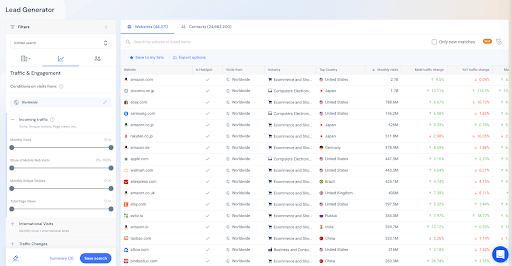How to Create a Killer Sales Pitch (And What to Avoid)

Your opening sales pitch is one of the most important parts of closing that deal. But, what does it take to make a winning sales pitch?
We take a look at what a sales pitch is, why they’re so important, how to make a great one yourself, and the most common sales pitch mistakes to avoid.
What is a sales pitch, and why is getting it right so important?
A sales pitch is where a salesperson explains what a business or product is, and why it’s beneficial. This can be over the phone, in a face-to-face meeting, or in a slidedeck, for example. Look at it like this:
Hook: your sales pitch.
Line: lead nurturing and education.
Sinker: closing that deal.
It’s vital to gaining the attention – and the interest – of your prospect. With a bad sales pitch, you’re unlikely to get another chance. But with a winning sales presentation, you’ll either move them quickly down the funnel, or be one they’ll call when the timing is right.
So, what makes for a winning sales pitch? Let’s go through the 6 main steps.
6 ways to make a winning sales pitch
Here are the 6 ways to make sure your sales pitch is on the road to success (and to customers converting…).
1) Research your prospect
If there’s one thing we won’t get bored of saying, it’s “research your prospect”. And we mean it. Before you think about how to write a sales pitch, research your prospect (yep, that’s the third time already) in every way you can before picking up that phone, entering that meeting room, or joining that Zoom call.*
By research, we mean both about the company, its goals, and perhaps even its shortcomings, but also about the individual or individuals you are speaking to. Think about why and how your product or solution applies to them, and how you can build rapport with them because, ideally, it won’t be the last time they’re talking with you.
*all equivalents included – you’re not getting away with this one.
2) Make it about them
That leads us nicely onto this section: make that sales pitch all about them. Use your research to adapt and personalize each pitch you do, so that they are specific and relevant to each prospect. Realistically, they will only really care about how they can benefit from your product – the rest might be (/probably will be) forgotten.
One thing that will take your research and personalization to the next level is data. Data that proves your product works in providing a solution for the client’s specific problem or needs.
“Where do we get the data from?”, we hear you ask. The answer = Similarweb Sales Intelligence.
While it almost feels like it’s data you shouldn’t be able to see, it’s actually completely legal and not creepy at all. See for yourself.
Above is our Lead Generator, where you can see the filter system on the left, making sure you’re seeing websites that meet the specifications of your ideal customer profile (ICP), as in, the ideal companies you solve for. This might include the types of industry, business size, business location, traffic amount, websites with fast-growing traffic – the works. You name it, our filter’s got it.
Then, you’ve got the cheeky Contacts tab along the top. “Cheeky” purely because it saves you a lot of time from searching the web in numerous ways to find an email address. We do it for you. You’ll find contact information for different roles within the company too, which is helpful if your pitch targets the CEO, the CFO, or the CTO.
As if that wasn’t enough, you can make the most of our Insights Generator tool. It gives you access to website data of each of your prospects and their competitors, allowing you to ✨ pimp up that pitch ✨ of yours with that all-important touch of personalization – yep, helping you to make it about them and how you solve their problems.
3) Ditch the jargon
‘Talking the talk’ doesn’t necessarily mean ‘walking the walk’ in this situation. In fact, it can be the opposite. Using confusing or complex language that your prospects may not understand – or even sales lingo that your prospects have heard all too often – could send them running in the other direction.
Keep it simple and to the point – but also make it conversational. It’s the best way to engage and educate your prospects, and to get them wanting to learn more about what you have to offer.
4) Offer a solution or a better way forward
By offering a solution or a better way forward, you are really making it hard for them to say no. Imagine:
You: “I can make your life a whole lot easier, and get you more revenue as a company”
Your prospect: “No, I’m good – thanks”
It’s an offer that’s hard to turn down. Sure, you’ll get some objections on price, current or competitive solutions, or other technicalities but, with a good pitch and deck, you can prove your product’s worth. Who can say no to an easier life or more revenue?
5) Anticipate objections before they arise
Leading on from that, you need to consider all potential objections before even making the pitch. Think about things that your prospect could be wary of: costs, integrations, moving from a current provider, missing out on deals from competitors, general workload, change.
By preparing for potential objections, you avoid hesitations and show how confident you are in your product. Confidence and surety are things that will shine through to your prospects, helping them overcome any doubts.
Ideally, your pitch will cover these objections before a prospect has time to ask – or even think – about them. For example, we always suggest having a slide in your deck that talks about your competitors. It gives you the opportunity to lever your business above the rest and point out your niche or USP – perhaps more naturally than fighting an objection would.
6) Outline the next steps
Right so, you’ve given a killer sales pitch and now you’re wrapping up the conversation with your prospect.
Now what?
Give them a roadmap.
Outlining the next steps to your prospect is all part of lead nurturing, and it forms a sense of commitment to one another. It might be a follow-up phone call a few days later, or even checking in before beginning a trial period for your product or work together. Let your potential client know exactly what (and when) to expect moving forward.
6 common sales pitch mistakes to AVOID
If you’re more motivated by the negatives, you’ve come to the right place. Here are 6 things to avoid when making a sales pitch – and I bet you can all relate to at least one of these in your past experience.
1) Too much information
When you reel off a lot of information at once, and sometimes about topics that your prospect won’t have fully grasped, you’re bound to lose their engagement. Attention spans are funny things, and throwing a load of new, hard-to-absorb information at them isn’t helpful to anyone.
So, here’s a hot tip: break it down.
Not only should you use simple and conversational language, you should make your pitch digestible by breaking it down into the necessities. Save yourself time by instigating certain questions in your client’s mind, and remember, do your pitch well and you’ll get through to Round 2. Ding, ding, ding.
2) Off-putting chat
Don’t say it, don’t say it, don’t say it… “Low-hanging fruit”.
We spoke about ditching the jargon in the to-do section, and boy, do we mean it. A conversational tone will get you so much further than a hard sell. And one traditional trait of a hard sell? Sales buzzwords.
While they might have worked way back when, these days, people can spot them a mile off. The thing with overused phrases – particularly when it comes to selling things – is they can quickly seem disingenuous, taking away from your authenticity and trustworthiness.
Being personable and relatable is a far better route to take. And don’t you forget it next time you touch base with your prospect. (Kidding).
3) Keeping it generic
A generic or broad sales pitch won’t get you anywhere. Let’s be honest, your sales pitch won’t be of interest until you spell out why it should be of interest to them. Make it worth your prospect’s time, otherwise they’ll zone out quickly.
This is exactly why research into your potential client, with data to back it, is what makes a winning sales pitch. You spot a problem or pain point, and you provide a specific solution for it. It’s a no-brainer, really.
4) Lack of visuals
Another way to make your prospects’ eyes glaze over is too much text, or too much talk. We talked about breaking down your pitch or presentation into digestible chunks, and another effective method is to include visuals.
Imagery , graphs , pie charts , videos – hey, even GIFS – will present all important information about your product in a fun and engaging way (and save your breath). These visuals are also great for sales enablement within your team, as well as collateral to remind clients that are further down the funnel.
5) Not leaving yourself enough time
So, let’s put the whole sales pitch process together. You’ve got your research period, your data searching, your diary syncing, and a prospect to convince. All of this takes time – and none of these points should be rushed for a solid (and retainable) lead.
We get it – time is precious, and so are those targets. To help, there are things you can do to speed up some of these processes, using Similarweb as a tool is one.
First, you can find the leads (yep, including the contact details) that meet the specs of your product’s ‘ideal buyer’ – like business type, business size, location, and so on – then, you can find insights about these specific leads and their website performance.
6) Playing (or just being) hard to get
You might be busy, but you’ve got to make yourself as available as possible to each and every one of your prospective clients. It’s all part of the lead nurturing process.
Some might be pinging you emails and requesting meetings non-stop, some you might not hear from until your next scheduled meeting.
They’re not your only client or lead, but you’ve got to make it seem that way. Be there rain or shine to assist with their questions or queries, and you’ll reap the benefits (and hopefully, the commission).
Sales pitch examples
Some of the best sales pitch examples will take both these lists into account, and prove great results too. And what better way to prove that than through videos from Shark Tank?
Beatbox Beverages
Sticking with our whole “confidence is crucial” point is this example from Beatbox Beverages. The neon-flavored, boxed fruit wine targets younger drinkers than typical wine-in-a-box. When the three co-founders entered Shark Tank asking for $250,000 for 10% of the company and didn’t get the offers they were looking for, they didn’t give up.
What happened?
One of the sharks asked the co-founders to pitch a counter-offer. The company’s representative did so with ease and with confidence, suggesting a cool $1 million dollars for a third of the company. The result? The shark agreed and the deal was done.
What’s the takeaway?
The co-founders were prepared to counter-offer with confidence. Being prepared for different responses can help you communicate with confidence and stay agile to ensure your pitch lands.
Bubba’s Boneless Ribs
This heart-filled pitch shows us the power of emotion and how it can make your sale.
Al “Bubba” Baker, founded the company to provide boneless and pre-cooked ribs. The key to Baker’s pitch was that he left the jargon aside and spoke to the shark’s emotions, explaining his problem. He loved eating ribs, but his wife struggled to make them for him. It was messy and it took a long time and she didn’t want to deal with it.
The Sharks connected with this sales pitch (it’s hard not to with such a persuasive personality) and Baker secured a $300,000 investment for licensing rights as well as %30 of the company.
What’s the takeaway?
Be real. Be yourself. And, most importantly, tap into the emotions of your audience.
More sales pitch examples
For more of the most impressive (and successful) sales presentations we’ve seen from shows like Shark Tank and Dragon’s Den, check out our recent post on 6 Winning Sales Pitches (and Why They Work).
The dos and don’ts of sales pitching
So, there you have it – what makes a good sales pitch… and what makes a bad one. Maybe this page is something to bookmark so you can check yourself and your sales pitch material to make sure you’re not slipping up unintentionally.
And remember, it doesn’t need to be a slog. There are some very helpful tools out there that can make it far more of a breeze…
FAQs
How do you start a sales pitch?
Research is key when it comes to creating your sales pitch. This should include extensive research about what you are selling and the company you are selling it to, but also research into sales pitch examples and tactics for inspiration (and experimentation).
What are some sales pitch examples?
Sales pitches can vary hugely, from company to company and salesperson to salesperson. Check the section above to find some winning sales pitch examples for inspiration.
What are some sales pitch tactics?
Whilst we’ve covered 6 important factors of a successful sales pitch, there are more sales pitch tactics for you to uncover.
Take your sales strategy to the next level
Try Similarweb Sales Intelligence today — free of charge









![How to Smash Your Next Sales Presentation [15 Tips and Tricks]](https://www.similarweb.com/blog/wp-content/uploads/2021/11/Tips-for-sales-presentations-1-768x456.png)
